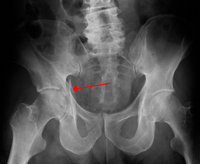
Photo from wikipedia
Objective Delayed presentation of complex acetabular fractures isn't uncommon. Surgical treatment of such fractures demand special consideration with respect to surgical approach, reduction techniques, fixation and avoidance of complications. This… Click to show full abstract
Objective Delayed presentation of complex acetabular fractures isn't uncommon. Surgical treatment of such fractures demand special consideration with respect to surgical approach, reduction techniques, fixation and avoidance of complications. This paper intends to review the literature with regard to the suggested treatment modalities and the reported outcome in late presentations and conclude any recommendations appropriate to the practice in current times. Background Displaced fractures of acetabulum, when remained untreated for more than three weeks, pose significant challenge to fracture reduction due to rapid callus formation. In 1976, Letournel described the "Extended Ilio-Femoral Approach"(EIFA) to provide adequate exposure for effective reduction of such fractures. It offered greater exposure of both anterior and posterior columns through a single window, which allowed more precise and controlled reduction of the complex fractures under vision. But despite early enthusiasm in its practice, there has been a steep decline in its application due to reported higher risk of complications. Despite the challenges, the accuracy of fracture reduction in complex acetabular fractures with late presentation was found to be superior in EIFA than the reduction that were achieved by other approaches. Hence a debate to find out the utility of this approach for late reconstruction of complex acetabular fractures (in the face of reported risks of complications) is worthwhile especially in younger patients, who are not suitable candidates for an acute hip replacement surgery and who need their native hip to function well at least for a few years, for their professional and personal high demand activities in their active youthful period. Methods The articles for review were retrived using Google Scholar for data retrieval as Pubmed didn't yield any meaningful results due to paucity of publication in this subject. There were only very few papers in the English literature since 1979, which focused on this condition and were considered for this review. We have included our experience on using EIFA in late presentations of complex acetabular fractures spanning from 1999 to 2019, an experience over two decades to this report. Results It was observed that despite delayed presentation, good articular reduction was possible by using EIFA even in complex acetabular fractures. Ultimate functional outcomes were directly related to the accuracy of fracture reduction thus achieved. The risk of heterotrophic ossification in EIFA, though emphasized as significant in the published literature, was found to be least of a problem in our experience. Discussion Surgical fixation in delayed cases of complex acetabular fractures was found to be challenging. The choice of surgical approach was found to have a great bearing on the accuracy of fracture reduction and long term functional outcome. In complex acetabular fractures, despite delay in presentation, precise reduction of such fractures was found to be possible when operated using EIFA. CONCLUSION: It was concluded that Every effort must be made to reconstruct the displaced fractures of acetabulum, even in the complex types,despite when they present late, provided the fracture fits into the selection criteria described by Letournel and operated using EIFA. This is very much appropriate to younger patients, who are not great candidate for total hip replacement surgery.
Journal Title: Journal of clinical orthopaedics and trauma
Year Published: 2020
Link to full text (if available)
Share on Social Media: Sign Up to like & get
recommendations!